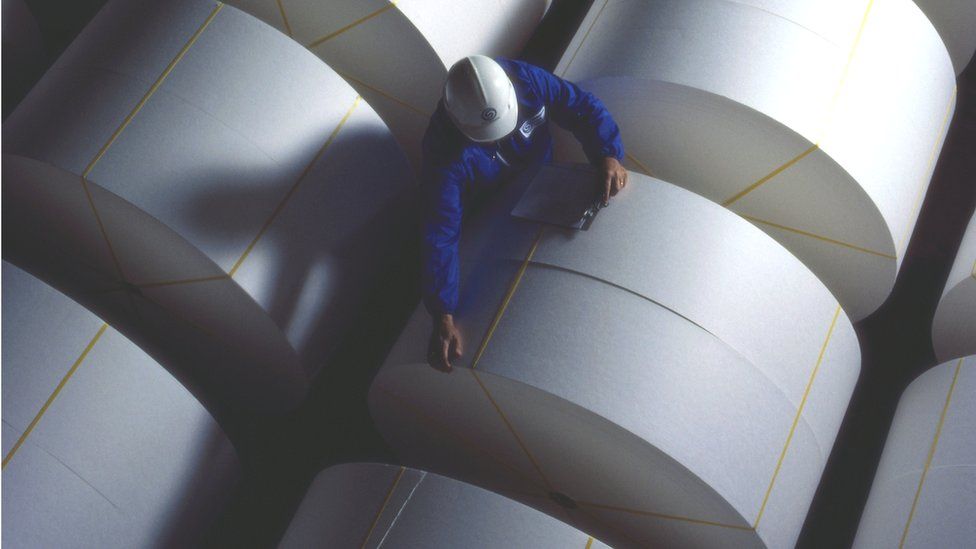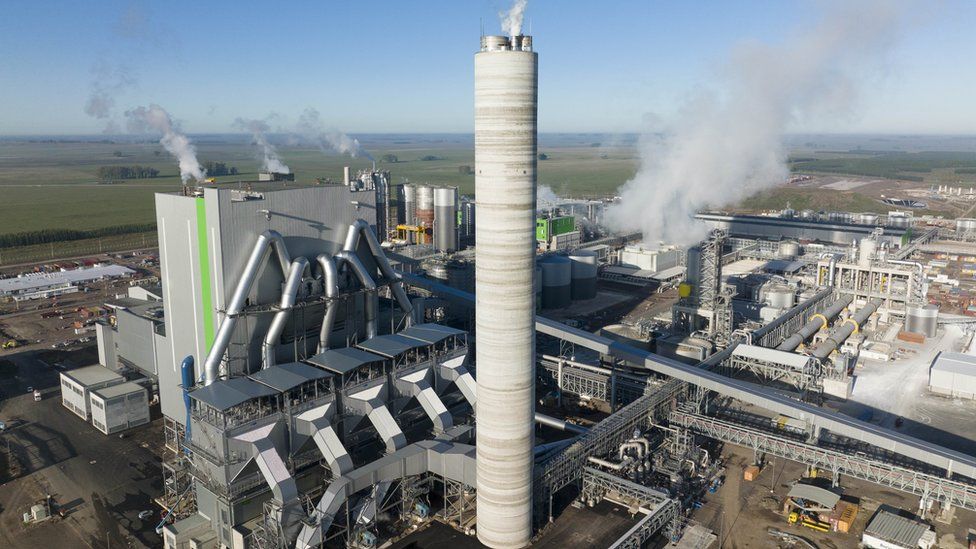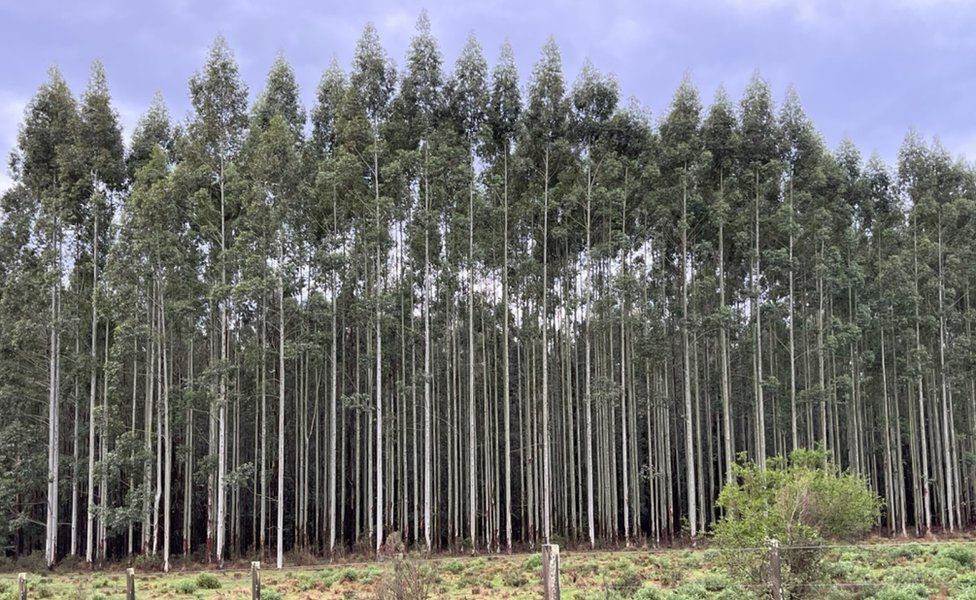Does the paper industry need to cut its water usage?

Paper is often seen as a green alternative to plastic, but the industry that produces it uses enormous quantities of water.
Companies in the pulp and paper sector say they are adopting new technologies to reduce the amount of water they need, but as our climate changes, are they moving fast enough?
One of the world’s largest pulp mills recently began operations in Uruguay, the UPM Paso de Los Toros facility in the centre of the country.
This came just as the nation was suffering its worst ever drought, sparking debate about its water use.
Uruguay’s capital, Montevideo, even ran out of fresh drinking water this year, after record low levels of rainfall.
For several months, the authorities had to take supplies from a river estuary where sea water mixes with fresh water, making tap water slightly salty.
Protestors, banging empty plastic bottles, came out on the streets, complaining that wood-pulping mills, and the forestry sector that supplies them, were using huge quantities of water.

“It’s true that there’s been a drought, but this crisis is caused by our economic model,” said Isabel Figari, one of the protestors. “Today, pulp mills have water, and we the people don’t.”
Uruguay’s pulp mills turn eucalyptus and pine wood into cellulose, which is then exported to be made into paper abroad.
The new facility in Paso de los Toros is run by Finnish company UPM. When working at full capacity it will produce 2.1 million tonnes of cellulose per year, doubling Uruguay’s total output.
This should see the country move from the world’s 12th to 11th largest producer, overtaking Chile.
The US is by far the biggest producer, followed by Brazil.
In UPM’s new mill the wood is chipped, then boiled with sodium hydroxide and sodium sulphide at high pressure. This dissolves the lignin in the wood leaving cellulose fibres.
The cellulose is then bleached using chlorine dioxide and hydrogen peroxide. The process needs a lot of water.
The mill takes 129 million litres of water a day from the local river, the Rio Negro. The waste water is then treated and pumped back into the river.

UPM runs another pulp mill, Fray Bentos, in south-west Uruguay. The company points out that both its facilities are several hundred kilometres from Montevideo, in areas where there is no water scarcity, so cannot be responsible for water shortages in the capital.
To reduce the amount of water it uses, the firm says it is applying the latest recycling technology. For example, when the wood chips are boiled in the Paso de Los Toros mill, the water vapour is condensed and used again.
After the cellulose is pulped, the water is extracted and then used in the subsequent bleaching process. Overall, the water is recycled 100 times before it is treated and is discharged into river.
“This is an area of continuous work and development,” says Marcos Battegazzore, vice president of UPM’s operations in Uruguay. “We have reduced the amount of water we take from the Uruguay River at Fray Bentos by almost 25%, and have also incorporated these water-saving technologies into our new plant in Paso de Los Toros.
“As technology develops there will be more possibilities to improve recycling levels within mills.”


New Tech Economy is a series exploring how technological innovation is set to shape the new emerging economic landscape.

Environmentalists in Uruguay are, however, not just concerned about the water usage of the pulp mills. They are also fearful that the waste water, despite it being treated, could still pollute rivers.
Dr Diana Míguez is a senior scientist at Latitud, a Uruguayan research group. Her doctorate degree considered whether effluent from the Fray Bentos mill affected the hormones of fish in the adjacent Uruguay River.
She found that when minnows, reared in her laboratory, were exposed to pulp mill effluent they produced half the number of eggs, as the control group. Her team also surveyed 1,000 native fish taken from the Uruguay River, and found that male fish caught downstream from the pulp mill had smaller testes.
UPM’s Mr Battegazzore says the company has “a very, very strict monitoring plan that includes the follow up of the biota in the river on annual basis and which involves local and international scientists”.
He adds: “This is the standard way of monitoring, and it began two years before the mill was in operation, so it’s a very reliable baseline. All this monitoring has revealed that there has been no change in the fish population in the river basin.”
UPM adds that the emissions of its Fray Bentos facility follow the European Commission’s “best available techniques” standards. Meanwhile, at the new Paso de Los Toros plant, the results of the water monitoring are uploaded in real time to the website of the Uruguayan environmental authorities for the public to see.
But concerns about pollution have risen after sodium hydroxide leaked from the Paso de los Toros plant in August. Dead fish and plants were found in a nearby stream and lagoon, according to Uruguayan environment ministry inspectors.
UPM says that they detected the substance in a field bordering the site, and took immediate corrective measures and informed the environmental authorities.
But it’s not just the water use of the mills that’s under scrutiny. More than 1.2 million hectares of Uruguay have been planted with eucalyptus or pine trees for turning into paper pulp.
Juan de Andrés is has a small cattle farm in the Cerro Largo department in the east of Uruguay. He thinks the eucalyptus plantations, which suck up a lot of water from the soil, are drying out his nearby land.
“When I was growing up we took water from a well,” he says. “We’d take 300 or 400 litres every day. Now I don’t think we can get 400 litres a week. With so many plantations, there’s an incredible competition for water.”

Uruguay’s industry minister, Omar Paganini, says there is no evidence after 30 years of eucalyptus plantations that they are reducing water levels in the country.
Unlike some parts of the world, where eucalyptus plantations replace natural forests, in Uruguay they are grown on grasslands.
Most experts in Uruguay – including UPM – agree that eucalyptus plantations do use more water than natural grasslands. The key factor is whether there is enough rain to replenish local water sources.
Daniel Panario is the director of the Environmental Science and Ecology Institute at Uruguay’s University of the Republic. He says in the rainy sub-tropical north of Uruguay, tree plantations do not reduce local water levels, but in the rest of the country, where there is less rain, they often do.
But wherever they are located, he says, monocultures degrade the soil and reduce biodiversity. “Eucalyptus and pines generate irreversible changes in the physical chemical properties of the soil. The soil becomes acidic very quickly,” he says.
